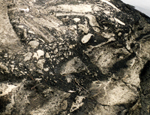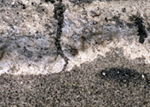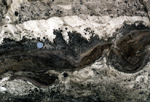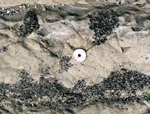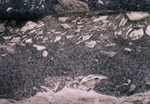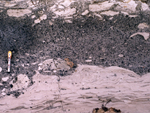Soft Sediment Structures
| Soft sediments in the accretionary prism in the ...Peninsulas provide amazing opportunities to understand the processes of dewatering and compaction in volcaniclastic sediments. These rocks are particularly interesting because the clasts have large variation in density, from very low density basaltic scoria with 50-60% porosity to small, dense basalt clasts with very small porosity. This variation, the rapid deposition of sediments during or soon after volcanic eruptions, and the high seismicity of the region, creates ideal conditions for the development of the variety of soft sediment structures described in this page. |
- Thrust: Eiko Gakuin
- Breccia Sill: Eiko Gakuin
- Diapir: Jogashima
- Local Gravity Instabilities
- Folds
- Stems
- Flow on sediments
- Neptunian dykes
Geological map of Tokyo
Bay 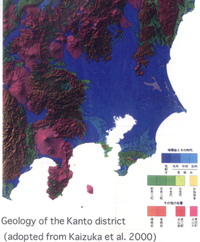 |
Thrust: Eiko Gakuin
This locality has a wide range of structures confined to particular layers within the sequence. These layers have a number of metric to decametric blocks within a coarse scoria matrix.
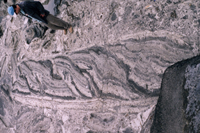 Sequence of thrusts preserved in a decametric block within a flow breccia |
Breccia Sill
Diapir
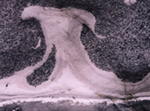
A) Diapir of silt |

B) Rayleigh-Taylor instability of a silt layer |
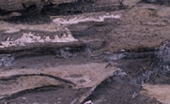
C) Faults cut the layer of diapirs shown in A) and B) |
Local Gravity Instabilities at Contacts
In the area amost every contact is unstable leading to some spectacular decimetric structures.
Folds
Blocks of folded soft sediments, deformed in the process of sediment flow, disruption and brecciation of the silt-rich layer by flow of the scoria matrix.

A) Fold from Nishikawana which must be scanned |
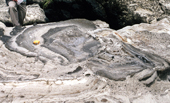
B) Sheath fold of a metric layer embedded in scoria matrix and intruded by a dyke of scoria |
Stems of diapirs, pipes
These are the stems which remove liquified, buoyant material from lower layers and allows their upward movement.

A) Stem at Jogashima |
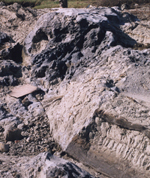
B) Stem at Nishikawana |
Flow on sediments
This is a layer in Eiko Gakuin, where a top silt layer which has been disrupted by flow, and the lower silt layer is only partly disrupted.
Neptunian Dykes
Neptunian dykes intruding from above. From Eiko Gakuin.
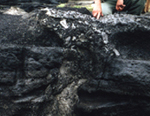
A) |
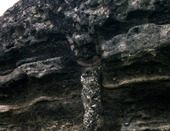
B) |
